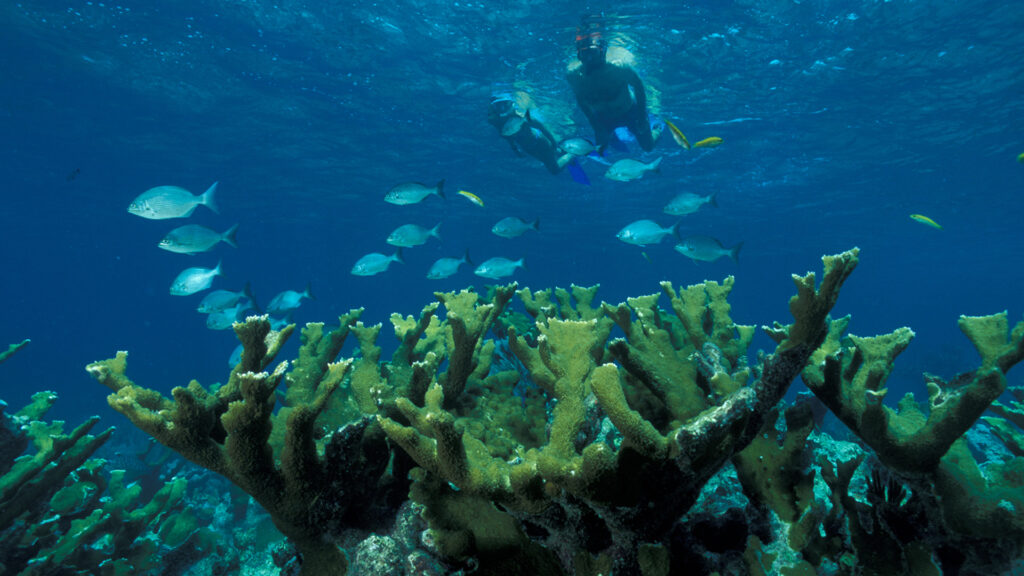By Rachel Silverstein, Miami Waterkeeper
As the last remaining corals on Florida’s reefs circle the drain of an ever-heating ocean, the National Oceanic and Atmospheric Administration (NOAA) has issued a new report that reminds us of another coral disaster.

The massive “Deep Dredge” of PortMiami, between 2013 and 2015, promised to turn Miami into a major shipping center for giant, post-Panamax ships. But it also devastated our most precious natural resource — likely killing millions of corals. And most of the damage has never been fixed. I say “most” because we did manage, after five years of litigation against the U.S. Army Corps of Engineers, to get 10,000 staghorn corals restored.
After the Deep Dredge concluded, the dredging company’s environmental-monitoring firm claimed, in the face of insurmountable evidence to the contrary, that the dredging had killed only six corals. But I’d been diving on those reefs during the dredging. I’d seen the moonscape of dead, sediment-smothered corals stretching for miles in every direction. I’d witnessed our reefs — which had formed the living architecture of a teeming ecosystem that had thrived for many millennia — blanch lifeless beneath the weight of millions of pounds of dredging offal.
In those early days, I was a brand-new Waterkeeper, recently graduated from the University of Miami with a Ph.D. in coral reefs. I knew then what we all know now: There was no way only six corals had died during the dredging.
I was determined to find the truth. I enlisted my former UM colleagues in a thankless task: the reanalysis of the monitoring firm’s owndata. We spent a year untangling its mess. By 2019, we published our analysis in Marine Pollution Bulletin, which proved the project had killed at least 560,000 corals, including, most egregiously, scores of corals listed as endangered species.
We sent our article to all the government agencies involved. We sat through endless meetings and sent meticulously researched letters. But it’s now been the better part of a decade and still no enforcement action has ever been taken.
Last week, that all changed. After seven years, NOAA has fully confirmed ourfindings and rejected the monitoring firm’s dubious claims. In the end, NOAA determined that the dredging project destroyed at least 278 acres of Florida’s reef and likely killed millions of corals. The report couldn’t be more timely.
Nearly a decade after the disaster at PortMiami, the Army Corps is proposing new dredging projects: in Puerto Rico, Fort Lauderdale — and in PortMiami again.
Do we care that, without our reefs, Miami’s coastline would start to look like any-old East Coast city? Remember that reefs are some of the most diverse biological habitats anywhere on the planet, injecting billions of dollars into the economy; protecting us from storm surges — not the kind of security blanket we should blithely cast aside in an age of heating oceans and ever-stronger hurricanes — and, in our case, serving as the inimitable backdrop for one of the most beautiful coastal cities in the world.

With this NOAA report, we have a rare chance to turn an environmental disaster into something positive, something valuable. In normal circumstances, reef restoration costs about $1.5 million an acre and entails dropping giant boulders on the now-decayed reef, hoping to resuscitate some of the bygone natural infrastructure. The boulders aren’t that effective at bringing a dying reef back to life and, with 278 acres of reef needing restoration, that’s a big bill.
So, here’s our chance. Instead of spending millions on ineffective boulders, we should instead invest the money on cutting-edge coral restoration projects being developed right now in South Florida, creating jobs, increasing coastal protection and turning our restored reefs into a shining example for the rest of the world.
I have two little boys who adore the ocean. Will they ever see the reefs I loved? Will they get to swim, as I often did, with the millions of sea creatures, large and small, whose priceless back yard we’ve inherited?
This may be our last chance to ensure that they do. Call your elected officials. Tell them you won’t stand for colorless coastlines. Tell them you want our children and grandchildren to enjoy the wondrous seascapes we’ve loved for so long.
Tell them the time to save our future is now.
Rachel Silverstein, Ph.D., has been the executive director and waterkeeper of Miami Waterkeeper since 2014. This opinion piece was originally published by the Miami Herald, which is a media partner of The Invading Sea.
If you are interested in submitting an opinion piece to The Invading Sea, email Editor Nathan Crabbe at ncrabbe@fau.edu. Sign up for The Invading Sea newsletter by visiting here.



